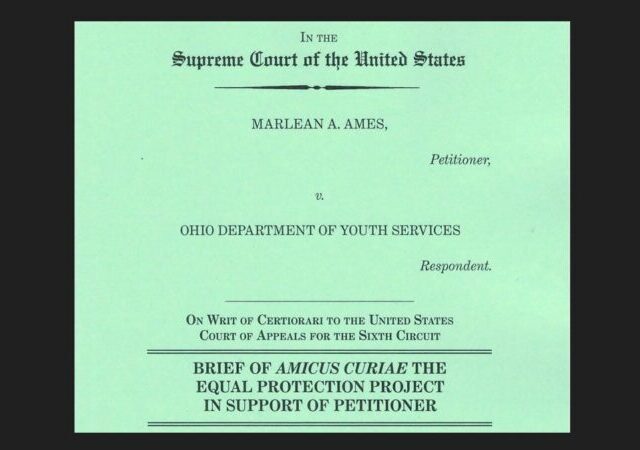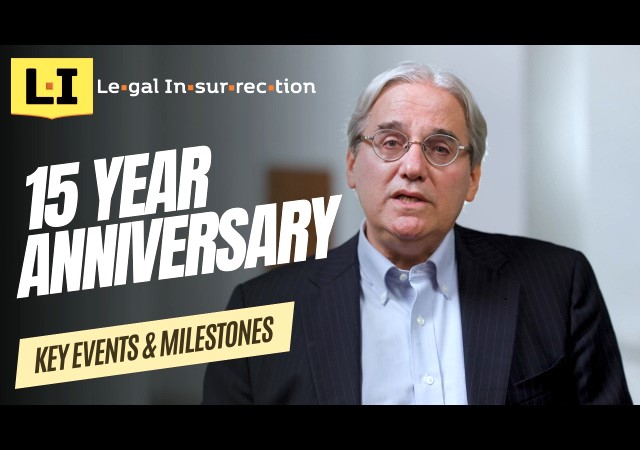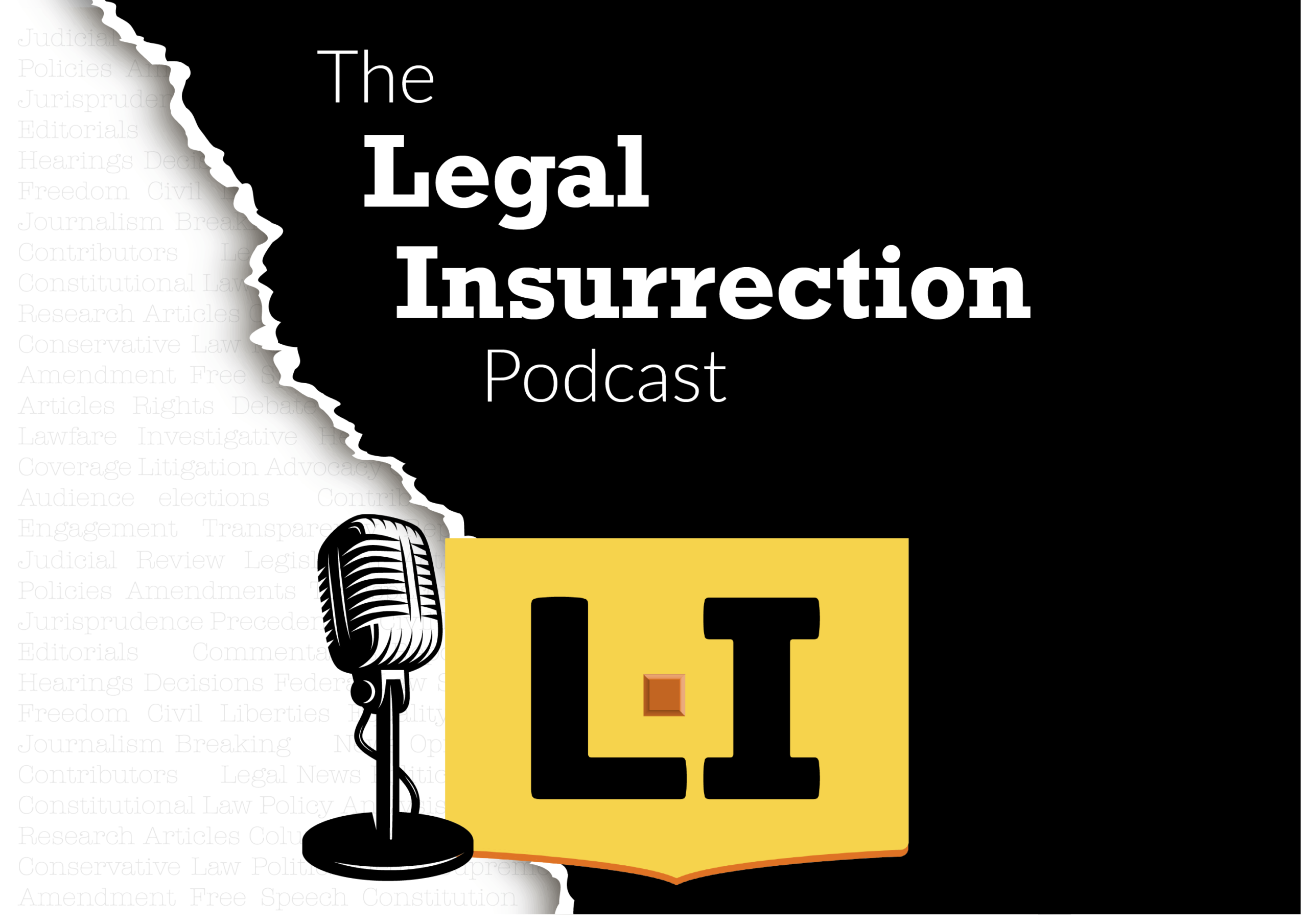Supreme Court Appears Ready to Give Reverse Discrimination Claims a Big Boost, and DEI a Big Blow
Justices hostile to claim that ‘majority’ plaintiffs have extra burden of proof. Justice Samuel Alito at oral argument raised point EPP made in its Amicus Brief, that discrimination against majority parties (White/Male/Straight) was no longer “rare”.

In December of last year the Equal Protection Project (EPP) (equalprotect.org) filed an amicus curiae, or friend-of-the-court, brief with the U.S. Supreme Court in an employment discrimination case in which a straight (i.e. not gay) woman was denied promotion and later demoted in favor of two gay persons who neither asked for nor were qualified for the jobs they got: Equal Protection Project Files SCOTUS Brief To Level Legal Playing Field For “Majority” Plaintiffs In Discrimination Cases:
EPP’s interest was piqued when we learned about a new U.S. Supreme Court case that highlights a strange, judge-made rule (i.e. it is not part of any statute or regulation) that makes it almost impossible for White, male, or other “majority” party plaintiffs in an employment case to prove discrimination in the courtroom and win.
In this case, titled Marlean A. Ames v. the Ohio Department of Youth Services, it was undisputed that Marlean Ames proved a prima facia case of discrimination because the Court agreed that she had been denied a promotion and then fired because she was “straight,” or heterosexual, and the two jobs Ames lost out on went to gay persons who were not even qualified for the jobs.
But Ames still lost the case.
Why? Because of the bizarre “background circumstances” rule. That rule, which was invented by the federal U.S. Court of Appeals for the District of Columbia Circuit in 1981, says that in addition to showing the normal factors of racial discrimination in an employment case (i.e. basically that a person was fired or not hired because of their race), a so-called “majority” plaintiff in a case of so-called “reverse discrimination” must also show “background circumstances [to] support the suspicion that the defendant is that unusual employer who discriminates against the majority.” Parker v. Baltimore & Ohio R.R. Co., 652 F.2d 1012, 1017 (D.C. Cir. 1981).
Is this rule found in Title VII, which governs discrimination in employment?
It is not.
The case made it all the way up to the Supreme Court, the parties filed their briefs, and, as mentioned, EPP filed an amicus brief supporting Marlean Ames, which you can review here.
The main argument EPP made in the brief is that while discrimination against so-called “majority” parties may have indeed been rare in 1981, it no longer is, and so the “background circumstances” rule is no longer needed:
[E]ven if the “background circumstances” rule had been correct when invented by the D.C. Circuit in Parker, it is no longer applicable or useful because discrimination against so called “majority” citizens is no longer “unusual,” but rather has become common. For example, of the over 40 cases of racial and sex discrimination EPP has filed civil rights complaints against since February 2023, most have entailed discrimination against “majority” parties…what was once “unusual” has now become ubiquitous, making the “background circumstances” requirement an anachronism that must be relegated to the dustbin of judicial history.
The Supreme Court heard oral argument on the case on Wednesday, February 26, 2025. We previewed the oral argument here: Supreme Court to Hear Oral Argument in Case Called “the Final Nail in DEI’s Coffin”:
EPP filed an amicus brief to argue that while the “background circumstances” rule might have had some validity when it was invented by the D.C. Circuit in Parker in 1981, it no longer does. Now it is commonplace for many employers to discriminate against majority parties.
It’s called DEI. You may have heard of it…
[F]or a…wide-ranging summary, with a…political bent, read all of Will the Supreme Court’s Decision in ‘Ames’ Be the Final Nail in DEI’s Coffin?:
From the article:
A wave of anti-DEI lawsuits, executive orders, and social media movements has swept the country. On Feb. 26, 2025, the United States Supreme Court will hear Ames v. Ohio Department of Youth Services, a case that directly impacts the growing anti-DEI “reverse discrimination” movement.
In deciding the case, the court is expected to clarify the requirements for a plaintiff to establish a prima facie case of reverse discrimination and may very well seal the fate of DEI in an already changing world…
The court will not decide Ames in a vacuum; employers already are under pressure from a series of recent anti-DEI reforms coming from the executive branch, private litigants, advocacy groups, social media influencers, consumers, and shareholders…
In any case, while the Ames case might turn on an arcane, and long-outmoded, legal rule, its implications for finally burying DEI are apparent. We are hoping for a positive outcome, where all people, regardless of race, sex, or sexual preference, are treated equally in discrimination cases in court.
Finally, one of the stranger things about this case is that on December 16, 2024, i.e. during the Biden Administration and more than a month before President Trump took office, Biden’s Solicitor General, Elizabeth Prelogar, who argues most of the federal government’s cases at SCOTUS, filed her own amicus brief on behalf of the “United States,” supporting…wait for it…Marlean Ames!! And now, the Trump Administration is running the show, and the Supreme Court has granted Prelogar’s motion to participate in oral argument (she got Petitioner Ames’ consent), so Ames will get 20 minutes, Prelogar will get 10 minutes, and then the Ohio Department of Youth Services will get 30 minutes.
It’s gonna be fun!
So Professor Jacobson and I listened intently to the live Supreme Court oral argument, and it was the strangest thing I (and maybe Professor Jacobson?) have ever heard; all nine of the Supreme Court Justices, counsel for the Petitioner, Marlean Ames, Counsel for the Government, Assistant to the Department of Justice’s Solicitor General Ashley Robertson, and Counsel for the Respondent, Ohio Department of Youth Services, all agreed that majority, i.e. White, Male, Straight, etc. plaintiffs should face the same burden to prove discrimination as any other plaintiffs.
In fact, much of the oral argument devolved into an argument over whether the Supreme Court’s opinion should just be a very short opinion simply saying exactly that. You can review the oral argument transcript here:
The New York Times has the story: Supreme Court Poised to Rule for Straight Woman in Discrimination Case: Justices across the ideological spectrum and lawyers on both sides agreed that an appeals court erred in requiring members of majority groups to meet a heightened burden:
The Supreme Court heard arguments on Wednesday over an employment discrimination suit filed by a straight woman who twice lost positions to gay workers. The case comes two years after the Supreme Court struck down race-conscious admissions programs in higher education and amid the Trump administration’s fierce efforts to root out programs that promote diversity. While some conservative groups have hoped the case will yield a major statement on efforts to diversify the workplace, it seemed likely to produce a modest decision saying merely that a key civil rights law applied equally to all employees.
Indeed, the argument was notable for what Justice Neil M. Gorsuch called the “radical agreement” among not only justices across the ideological spectrum but also, remarkably, all of the lawyers in the case. They all said that an appeals court had gone badly astray in imposing a heightened burden for members of majority groups seeking to prove workplace discrimination.
The court seemed likely to issue a brief and perhaps unanimous decision in favor of the woman, Marlean A. Ames. Justice Brett M. Kavanaugh said he envisioned “a really short opinion that says discrimination on the basis of sexual orientation, whether it’s because you’re gay or because you’re straight, is prohibited, and the rules are the same.”
Counsel for Respondent, although agreeing that the burden for proving discrimination should be the same for all, seemed to be arguing that Ms. Ames really hadn’t proved her discrimination case, but the Court is unlikely to tackle that issue without a lower court addressing that exact issue first.
Another good summary of the Court’s oral argument from Amy Howe at SCOTUSBLOG is here: Court appears likely to side with straight woman in reverse discrimination suit.
One other key point is that during the oral argument, Justice Samuel Alito specifically cited the main argument EPP made in its amicus brief. From Justice Alito:
“[T]he rule that the Sixth Circuit applied was apparently based on an intuition about the way in which most employers behave. And maybe it was sound at the time when McDonnell Douglas was decided. Maybe, as some of the amici have argued, it’s no longer sound today. Suppose we say that that was an error.”
[emphasis added]
From EPP’s amicus brief:
[E]ven if the “background circumstances” rule had been correct when invented by the D.C. Circuit in Parker [and McDonnell Douglas], it is no longer applicable or useful because discrimination against so called “majority” citizens is no longer “unusual,” but rather has become common. For example, of the over 40 cases of racial and sex discrimination EPP has filed civil rights complaints against since February 2023, most have entailed discrimination against “majority” parties. In fact, a recent addition to the EPP team, Professor Mark Perry, has filed over 2,000 civil rights complaints in cases involving Title VI and Title IX race and sex discrimination, most of which involved discrimination against majority parties. As the organization Do No Harm, which advocates for “keeping identity politics out of medical education, research, and clinical practice,” has stated, “[a]lmost every U.S. medical school has at least one scholarship, fellowship, clerkship, award, special preference, or academic program that violates federal civil rights laws. Most of them involve favoritism toward students typically considered to be Underrepresented in Medicine (URiM).”
In other words, these programs routinely discriminate against majority parties. In sum, what was once “unusual” has now become ubiquitous, making the “background circumstances” requirement an anachronism that must be relegated to the dustbin of judicial history.
It’s nice to know that the Supreme Court Justices had read EPP’s brief, and thought enough of its key argument to raise it in court.
Professor Jacobson’s prediction is that the case will be a unanimous decision by the Court, with a concurrence from one of the liberal justices stating that this case’s holding is limited to Title VII employment cases and should have no bearing on Title VI racial discrimination cases in which, for example, White students are not allowed to even apply for certain scholarships at certain colleges.
So, while this case might not be the “final” nail in DEI’s coffin, it will probably still be a significant one, and that’s a good thing. And EPP is proud to have helped move the Court in the right direction.
The Supreme Court is likely to kill a bizarre DEI rule, in Ames v. Ohio | Vox https://t.co/JofUM7K0tp
— berry
(@SimplyBerry) February 26, 2025
 DONATE
DONATE
Donations tax deductible
to the full extent allowed by law.









Comments
With a clear case of immutable characteristics discrimination, why should any court, even in 1981, have felt it necessary to place an additional burden on the person discriminated against?
I would say that cases of clear discrimination against blacks would be the rarity today and its unlikely that those plaintiffs would bear that additional burden of proof.
Great work, Professor! I’m very hopeful SCOTUS will rule as you predict and another brick in the wall of America’s decline will fall.
and TY James, Hope you guys are right.
The D.C. Circuit stands for Disregard Constitution.
Better still would be a straightforward decision ending all race based judicial presumptions that create special burdens or create special demands for any litigant and simply put every litigant on the same footing for due process and equal protection.
The justices on Supreme Court are considering how they will weigh in, except for one justice who already knows how she will vote on racial issues before ever hearing a case.
I think there’s at least two that fit that description.
One of the commenters at Jonathan Turley’s blog looked up the original decision where the claim that it’s an unusual employer who discriminates against the majority originated, to see what evidence or argument that claim was based on. He found that there wasn’t any. It was a pure assertion by the court, based on nothing at all.
Why did someone downvote Milhouse on this comment? Surely no one here is dumb enough to downvote someone without even reading the comment they’re downvoting….right?
“[E]ven if the “background circumstances” rule had been correct when invented by the D.C. Circuit in Parker [and McDonnell Douglas],”
It wasn’t correct then and still isn’t. Discrimination whether against the majority or minority is and always has been wrong. Over 30 years ago I spent 4 years at a university, graduated in the top 5 of my class and was told by a government entity they would love to hire me but couldn’t because they had to hire women and minorities. Having just come out of the military where you got promoted on merit I thought that was bull then and still do. Are you the most qualified person for the job or aren’t you?
My father worked for a small custom-component electronics company. Naturally they made a lot of things for government-related prototype projects.
At one point he came home complaining that the company had needed a specialized type of engineer but could not hire one because the government was demanding that the next engineer they hired be …a minority.. (and Asians don’t count). They found a White engineer and hired him, with a janitor’s title and THAT was okay with the government, Naturally he was the best-paid janitor in the country…
I think that is why you can’t read a job title and figure out what the job is for.